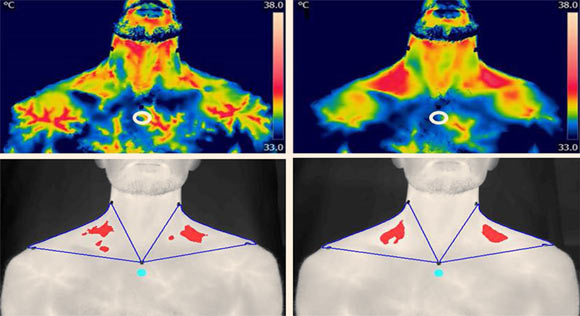Drinking a cup of coffee can stimulate brown adipose tissue (also known as brown fat), an important part of the human body which plays a key role in how quickly we can burn calories as energy, according to a study published this week in the journal Scientific Reports.

Caffeine present in a standard coffee beverage can elicit a thermogenic effect on brown adipose tissue in adult humans. Image credit: StockSnap.
Brown adipose tissue is one of two types of fat found in humans and other mammals.
Initially only attributed to babies and hibernating mammals, it was discovered in recent years that adults can have brown fat too.
Its main function is to generate body heat by burning calories (opposed to white fat, which is a result of storing excess calories).
People with a lower body mass index (BMI) therefore have a higher amount of brown fat.
“Brown fat works in a different way to other fat in your body and produces heat by burning sugar and fat, often in response to cold,” said Professor Michael Symonds, from the School of Medicine at the University of Nottingham.
“Increasing its activity improves blood sugar control as well as improving blood lipid levels and the extra calories burnt help with weight loss.”
“However, until now, no one has found an acceptable way to stimulate its activity in humans.”

In vivo effect of drinking caffeine on heat production from brown fat in adult humans: representative thermal image (left) pre and (right) post-caffeine, as either the original FLIR image, or the transformed image high-lighting the hottest 10% of pixels. White open and blue closed circles indicate the reference temperature point. Image credit: Velickovic et al, doi: 10.1038/s41598-019-45540-1.
Professor Symonds and colleagues started with a series of stem cell studies to see if caffeine would stimulate brown fat.
Once they had found the right dose, they then moved on to humans to see if the results were similar.
The researchers used a thermal imaging technique, which they’d previously pioneered, to trace the body’s brown fat reserves.
“From our previous work, we knew that brown fat is mainly located in the neck region, so we were able to image someone straight after they had a drink to see if the brown fat got hotter,” Professor Symonds said.
“The results were positive and we now need to ascertain that caffeine as one of the ingredients in the coffee is acting as the stimulus or if there’s another component helping with the activation of brown fat.”
“We are currently looking at caffeine supplements to test whether the effect is similar.”
“Once we have confirmed which component is responsible for this, it could potentially be used as part of a weight management regime or as part of glucose regulation program to help prevent diabetes.”
_____
Ksenija Velickovic et al. 2019. Caffeine exposure induces browning features in adipose tissue in vitro and in vivo. Scientific Reports 9, article number: 9104; doi: 10.1038/s41598-019-45540-1







